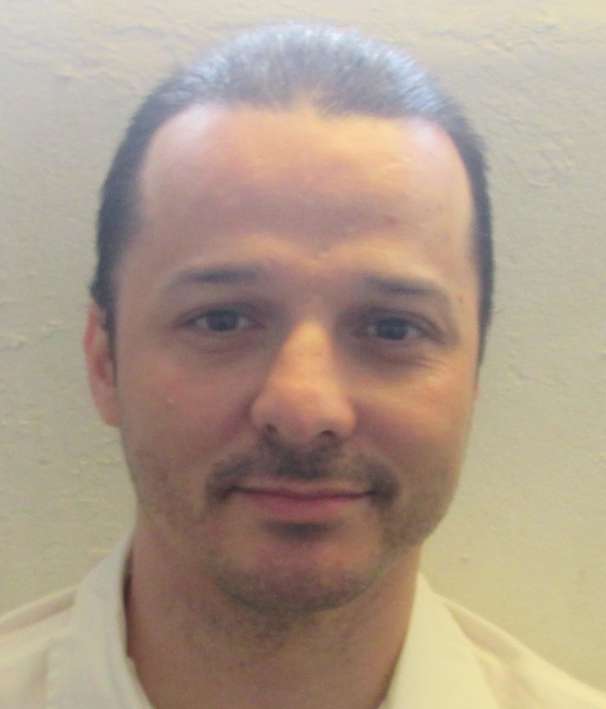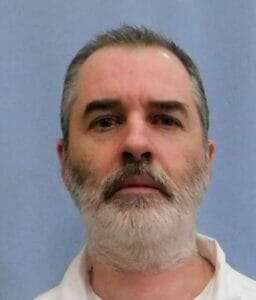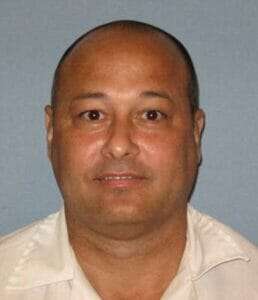
James Yeomans was sentenced to death by the State of Alabama for the murders of his ex wife and her parents. According to court documents James Yeomans would enter his ex wives home and would shoot and beat the three victims causing their deaths. James Yeomans would be arrested, convicted and sentenced to death
James Yeomans 2021 Information
| Inmate: | YEOMANS, JAMES DONALD |
| AIS: | 0000Z678 |
| Institution: | HOLMAN PRISON |
James Yeomans More News
ody Simmons, the 21-year-old son of victims Jake and Sylvia Simmons and the sister of victim Julie Yeomans,3 testified that in November 1999, when the murders occurred, he was 20 years old and was living at home with his parents. He left the house at 6:30 a.m. on the day of the murders, a Monday, leaving his parents, Julie, and her three children in the kitchen. Julie and the children had spent the previous night with their parents, he said. He returned home at 11:30 a.m. to have lunch, and he noticed that a window on his mother’s automobile had been broken. When he entered through the back door of the house he immediately noticed that a shotgun, which was usually kept in a bedroom closet, was lying across a chair in the den near the back door. As Jody walked into the house, he saw his mother’s purse on the table, so he walked toward the living room to see whether anyone else was home. He then saw his mother just inside the living room doorway, covered in blood. His father was on the living room floor, also covered in blood. Jody left the house and drove to the police station; he had not seen the body of his sister, Julie. He did not return to the house that day.
On cross-examination, Jody stated that Julie had been married to another man before she married Yeomans. She and her first husband had two children, Casey and Brandon. She and Yeomans had a daughter, Lee Ann, who was two years old at the time of the murders.
Baxter Etheridge testified that on the morning of the murders he traveled past the Simmons house between 7:30 and 8:00 a.m. As he passed by the house, he saw a young woman jump off a small porch and push a tall, slender man so hard that he was almost knocked down. Etheridge stated that after he drove for approximately one mile, he turned his vehicle around to drive past the house again to be sure that everything was all right. When he passed the house again, he saw the young woman standing beside a car; it appeared to him that she might have been crying. He did not see the tall, slender man or anyone else at that time. Etheridge testified that he turned his vehicle around again in order to continue in the direction he had originally been traveling that morning. When he passed by the Simmons house the third time, a few minutes after his second pass by the house, he did not see the woman standing by the car, but he saw someone in the doorway of the house. It appeared that the person was backing into the house and was pulling something into the house with him. Officer Keith Galloway of the Geneva Police Department testified that at 1:22 a.m., several hours before the murders, he saw Yeomans and his teenaged son walking on a rural road. Galloway stopped Yeomans to ask what he was doing out there at that time of night, and Yeomans told him he was going to see his brother-in-law to get a ride to work. Galloway thought his answer was odd, because he knew that Yeomans worked at Outdoor Aluminum, and Yeomans had already walked past that business by the time Galloway stopped him.
Marion Spivey testified that at approximately 7:00 a.m. on the day of the murders, he was driving a tractor on the road behind the Simmons house. He saw Jake and Sylvia Simmons and Julie and James Yeomans talking in the front yard. He saw a small child standing behind the adults. He did not see anyone pushing anyone else, and he did not hear anyone shouting.
Casey Rogers testified that he was nine years old and that his mother was Julie Yeomans. He was eight years old when his mother was killed, and he had been living with his mother, his younger brother and sister, and James Yeomans. Yeomans’s two sons, Alan and Donald, were also living with them. Casey said that Yeomans and his mother argued and fought on Saturday night before the murders. He did not know whether his mother hit Yeomans, but he thought “a couple of licks was passed.” (R. 491.) Casey testified that his mother pulled a knife on Yeomans and told him that he had better stay away from her. Casey said that he thought that his mother was injured that night.
On Sunday morning, Casey’s grandparents, Jake and Sylvia Simmons, came to the Yeomanses’ residence. Casey said that he was playing with a triangle-shaped “football” made from a piece of notebook paper. Before Casey and his four-year-old brother, Brandon, left with their grandparents, Julie took Casey’s paper football and told him that she wanted to write his name in it. When Casey got into his grandparents’ car, he unfolded the paper football because his mother often drew pictures for him on such occasions. This time, Julie had written him a note, Casey said. The note instructed Casey to say nothing to his grandparents about what had happened between her and Yeomans until they had left the yard. Sylvia Simmons took the note from Casey and put it in her purse.
After the Simmonses left the Yeomanses’ residence with Casey and Brandon, they drove to the police station. After the grandparents spoke to the police, they went to the Simmonses’ residence. Sometime later, on Sunday evening, Julie arrived at her parents’ home and she brought Lee Ann, Casey’s younger half-sister, with her. Julie and the three children spent the night with the Simmonses.
Casey testified that all of the family members were awake and in the kitchen on Monday morning when his Uncle Jody went to work. Casey said that the rest of the family intended to enroll him in the local school that morning. Casey, Brandon, and Lee Ann were in the backseat of their grandparents’ automobile, he said, and his mother and grandparents were coming outside to get into the car. Yeomans and his son, Alan, appeared from behind the carport. Yeomans told Julie that he wanted her and Lee Ann to come home with him. Casey said that his mother refused and she told Yeomans that “she was tired of being beaten on․” (R. 502.) Yeomans then told Julie to get Lee Ann and her belongings and he would take her home. Casey said that Julie refused Yeomans’s request, and the two argued and yelled.
Casey testified that his grandfather said he was going to get his shotgun and walked toward the house. Yeomans told Alan to block the door, and he did. Casey said that Alan and Jake “tied up and wrestled and fell down the stairs and stuff.” (R. 503.) Casey said that, somehow, Yeomans got his mother and grandmother into the house. The three children had remained in the car during this time.
Casey and Brandon then got out of the car. At Casey’s direction, the car doors were locked with Lee Ann inside. Casey explained, “I just wanted to keep her as safe as I could because I didn’t think she wanted to see what was going to happen.” (R. 504.) Casey and Brandon then ran toward the house. Jake and Alan were still wrestling in the yard.
When Casey entered the house, he saw his grandmother on the floor. He knew she had been hurt because her glasses were broken and had fallen off and blood was “coming out of her face.” (R. 505.) Casey asked where his mother was, and his grandmother pointed toward the hallway. Casey went to his mother, who was on the floor “with blood coming out of her head.” (R. 506.) Casey hugged her and got blood on his shirt, he said. Yeomans told Casey and Brandon to sit on the couch, and they did. Casey said that he and Brandon were crying and that Brandon was screaming, so Yeomans told them, while brandishing a metal pipe, to shut up or they would be next. Casey had previously seen the metal pipe in his grandparents’ front yard. Yeomans went outside, and Casey went to check on his mother. He asked Julie what had happened and she told Casey that Yeomans had hit her. Casey asked what Yeomans had hit her with, because he knew Yeomans could not have hit her that hard with his hand and because he had not seen Yeomans hit his mother. Julie did not answer Casey’s questions, so he returned to the couch.
Casey testified that he saw Yeomans drag Jake Simmons by the hand up the porch stairs and into the house. He then saw Yeomans hit his grandfather on the head with the pipe. Casey said that he and Brandon remained on the couch while his mother and grandparents were on the floor, beaten. His mother and grandparents were moaning and groaning, Casey said. Yeomans went to Casey’s grandmother, said something like, “Shut up, you bitch,” and pushed her with his foot.
Yeomans told Alan to go outside to get Lee Ann out of the car, which he did. Casey testified that Yeomans then checked Jake’s shotgun and found that it was not loaded. Yeomans then went to Jody’s room and retrieved the .22-caliber rifle Jody kept there. Yeomans told Alan to take Lee Ann and the boys to another room and to keep them there. Casey saw Yeomans go into the living room and he heard at least three gunshots. Yeomans then told the children to get into their mother’s car. Casey identified his mother’s purse and said that Yeomans took it with them when they left the crime scene.
Yeomans drove with the four children to his sister’s house in Florida. When a police officer arrived at the sister’s house, Casey told him that two black men had broken in and killed his mother and his grandparents and that Yeomans had knocked the men out and saved the children. Casey testified that Yeomans told him to tell the police that story. Casey said he did as Yeomans instructed because Yeomans also said that if Casey and Brandon told the truth instead, he would kill them. On cross-examination, defense counsel asked Casey if, during the drive to Florida, he, not Yeomans, had concocted the story about the two black men killing his mother and grandparents. Casey denied that he had done so and stated, “I didn’t say a whole word the whole time we were riding up there. I was too scared to speak. I was afraid I would say the wrong thing and I would get killed. That’s what I was afraid of.” (R. 523.) Tommy Merritt, an agent with the Alabama Bureau of Investigation, testified that he traveled to the Simmonses’ home at approximately 1:00 p.m. on the day of the murders. He identified photographs of the crime scene that were taken before the victims’ bodies were removed from the residence. He also identified a diagram of the crime scene that he drew that day.
Merritt testified that the window on the passenger side of the car in the Simmonses’ yard had been shattered. A large pipe wrench was on the floorboard of the driver’s side of the car, which suggested to Agent Merritt that the wrench had been thrown in to break the window. He said that several items were recovered close to the front door of the house, including a shotgun shell, a man’s shoe, and a baseball cap. Jake Simmons was wearing only one shoe when his body was recovered inside the home.
Merritt stated that a loaded shotgun was found on a chair near the back door of the house and that a .22-caliber rifle was found in a hallway between the living room and a bedroom. The rifle was near the body of Julie Yeomans. Agent Merritt also said that a metal pipe approximately 2 to 2 1/2 feet long was found on top of an old stove in the dining area. The pipe was stained with what appeared to be blood. Several spent shell casings and bullets from a .22-caliber rifle were found inside the home.
Agent Merritt testified that Jake and Sylvia Simmons and Julie Yeomans had obvious wounds to their heads and that they had bled profusely from the wounds. He testified that each victim appeared to have been shot. A dead dog was also discovered near the victims. Like the human victims, the dog was lying in a pool of blood. A videotape of the crime scene was played for the jury.
Dr. Alfredo Parades, a forensic pathologist, conducted autopsies on Jake and Sylvia Simmons and on Julie Yeomans. He testified that Jake Simmons suffered multiple blunt-force injuries to his face and to the top and back of his head. The left side of Jake’s face was “partially collapsed” as a result of the extensive fracturing of the bones of the face. Jake suffered defensive wounds to his right hand, and he was also shot through the face and the brain with at least one bullet. Dr. Parades testified that the bruising around the injuries indicated that Jake was alive when all of the injuries were inflicted. Dr. Parades stated that Sylvia Simmons suffered multiple cuts and fractures to her head and skull, and she suffered much bleeding and bruising inside her brain as a result of the injuries. Dr. Parades stated that Sylvia was struck at least 10 times on the head. Sylvia was alive when at least some of the head injuries were inflicted. She also sustained a gunshot wound that entered her right cheek, then traveled up and back, lodging in the left side of her brain. Sylvia was struck by “a massive blow” on the left wrist that caused a fracture and deformity of both bones of the wrist. Dr. Parades stated that the injuries to the wrist were defensive wounds and that they were consistent with the width of the metal pipe recovered from the scene. The back of Sylvia’s right hand and her right arm and wrist also sustained defensive wounds. The cause of Sylvia’s death was blunt-force injuries to the head and a gunshot wound to the face.
Julie Ann Yeomans was beaten on the head and she was shot repeatedly. Dr. Parades testified that one of the bullets entered the right side of her neck, then traveled downward and exited the back of Julie’s central chest area. Another of the bullets grazed her face and passed through her earlobe; another bullet entered through her right temple area; another bullet entered through her right cheek. Two of the bullets left fragments in Julie’s brain. Julie was also shot through her right eye and through her mouth. Dr. Parades opined that Julie was alive each time she was shot, because bruising was visible around the entrance wounds. Dr. Parades stated that Julie died as the result of the multiple gunshot wounds to the face and neck and as a result of the multiple blows to the top and side of her head.
Dr. Parades performed an autopsy on the dog that was found dead at the scene. The dog was shot in the chest; the bullet penetrated the lungs and the aorta, and the dog bled to death internally.
https://caselaw.findlaw.com/al-court-of-criminal-appeals/1487284.html








